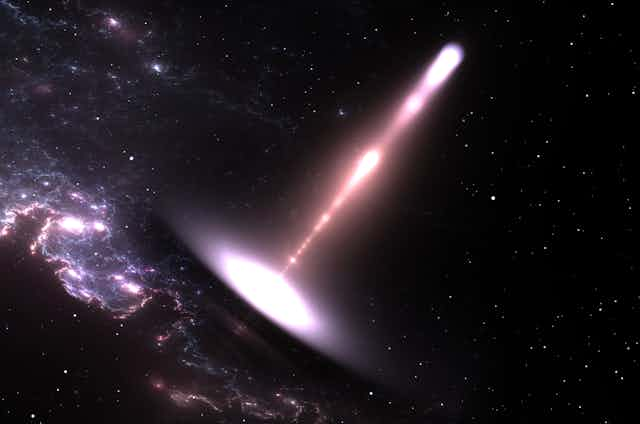Astronomers at Western Sydney University have discovered one of the biggest black hole jets in the sky.
Spanning more than a million light years from end to end, the jet shoots away from a black hole with enormous energy, and at almost the speed of light. But in the vast expanses of space between galaxies, it doesn’t always get its own way.
At a mere 93 million light-years away, the galaxy NGC2663 is in our neighbourhood, cosmically speaking. If our galaxy were a house, NGC2663 would be a suburb or two away.

Looking at its starlight with an ordinary telescope, we see the familiar oval shape of a “typical” elliptical galaxy, with about ten times as many stars as our own Milky Way.
Typical, that is, until we observed NGC2663 with CSIRO’s Australian Square Kilometre Array Pathfinder (ASKAP) in Western Australia – a network of 36 linked radio dishes forming a single super-telescope.

Black hole jets from NGC2663 compared to a jet engine. Top image: observations from the ASKAP radio telescope. Bottom: a methane rocket successfully being tested in the Mojave Desert. Note the patterns of compression ( Mike Massee/XCOR, used with permission, Author provided
As well as in jet engines, shock diamonds have been seen in smaller, galaxy-sized jets. We’ve seen jets slam into dense clouds of gas, lighting them up as they bore through. But jets being constricted from the sides is a more subtle effect, making it harder to observe.
However, until NGC2663, we’ve not seen this effect on such enormous scales.
This tells us there is enough matter in the intergalactic space around NGC2663 to push against the sides of the jet. In turn, the jet heats and pressurises the matter.
This is a feedback loop: intergalactic matter feeds into a galaxy, galaxy makes black hole, black hole launches jet, jet slows supply of intergalactic matter into galaxies.
These jets affect how gas forms into galaxies as the universe evolves. It’s exciting to see such a direct illustration of this interaction.
The EMU survey, which is also responsible for identifying a new type of mysterious astronomical object called an “Odd Radio Circle”, is continuing to scan the sky. This remarkable radio jet will soon be joined by many more discoveries.
As we do, we’ll build up a better understanding of how black holes intimately shape the galaxies forming around them.
Luke Barnes, Lecturer in Physics, Western Sydney University; Miroslav Filipovic, Professor, Western Sydney University; Ray Norris, Professor, School of Science, Western Sydney University, and Velibor Velović, PhD Candidate, Western Sydney University
This article is republished from The Conversation under a Creative Commons license. Read the original article.





